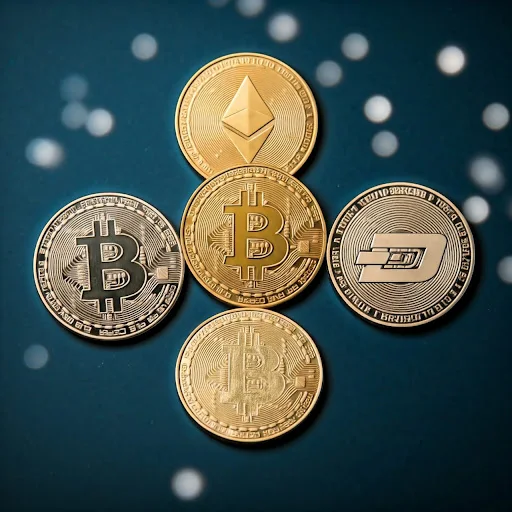USDJ: A Stablecoin Revolution in Decentralized Finance
The cryptocurrency world has evolved rapidly over the past decade, and one of its most notable innovations is the stablecoin. Stablecoins, which are designed to maintain a stable value, play a crucial role in the decentralized finance (DeFi) ecosystem by mitigating the volatility typically associated with cryptocurrencies. Among these, USDJ stands out as a unique algorithmic stablecoin, designed to maintain its peg to the US dollar while operating within the TRON blockchain ecosystem.
This article delves into the features, benefits, and applications of USDJ, its role in DeFi, and its potential to shape the future of the cryptocurrency market.
What is USDJ?
USDJ is a decentralized, algorithmic stablecoin pegged to the US dollar, functioning on the TRON blockchain. Unlike traditional stablecoins backed by fiat reserves, USDJ is collateralized by digital assets, particularly TRON-based tokens. It is created through a smart contract system known as JustStable, part of the broader JUST ecosystem.
USDJ maintains its dollar peg by leveraging over-collateralization and automated smart contract mechanisms, ensuring stability while providing transparency and decentralization.
Key Features of USDJ
1. Decentralization
USDJ operates without centralized control, relying on smart contracts to manage collateral and maintain its peg.
2. Over-Collateralization
To mint USDJ, users must lock collateral in the form of TRON-based tokens, ensuring the stablecoin is backed by assets with higher value than the USDJ in circulation.
3. Smart Contract-Based Stability
The stability of USDJ is achieved through automated smart contract mechanisms that manage the minting and burning processes, ensuring the peg is maintained.
4. TRON Blockchain Integration
As part of the TRON ecosystem, USDJ benefits from fast transaction speeds, low fees, and robust network infrastructure.
5. Transparency
All transactions and collateral data related to USDJ are publicly accessible on the blockchain, providing complete transparency to users.
How USDJ Works
USDJ is created and managed through the JustStable protocol, which involves the following steps:
1. Collateralization
Users deposit TRON-based assets, such as TRX or other supported tokens, into a smart contract called a Collateralized Debt Position (CDP).
2. Minting USDJ
Based on the collateral deposited, the system mints USDJ tokens, which are issued to the user. The collateral must exceed the value of USDJ issued to maintain stability and protect against price fluctuations.
3. Repayment and Redemption
Users can repay their USDJ to unlock the collateralized assets. If the collateral value falls below a certain threshold, the system may liquidate the assets to ensure stability.
4. Peg Maintenance
The algorithm adjusts minting and burning activities based on supply and demand dynamics to maintain the $1 peg.
Advantages of USDJ
1. Decentralized and Autonomous
USDJ operates on a decentralized protocol, eliminating the need for intermediaries and centralized authorities.
2. Trustless System
Users don’t need to trust a central entity for collateral management, as everything is managed through smart contracts.
3. Low Transaction Fees
Operating on the TRON blockchain, USDJ offers minimal transaction costs compared to Ethereum-based stablecoins.
4. Fast Transactions
The TRON network provides lightning-fast transaction speeds, ensuring smooth and efficient use of USDJ.
5. Ecosystem Integration
USDJ seamlessly integrates with DeFi platforms, decentralized exchanges (DEXs), and payment systems within the TRON ecosystem.
Use Cases of USDJ
1. DeFi Applications
USDJ is widely used in lending, borrowing, and liquidity provision within DeFi protocols, offering users a stable medium of exchange.
2. Trading and Hedging
Traders use USDJ as a stable asset to hedge against market volatility or to store value during uncertain times.
3. Remittances and Payments
USDJ facilitates cross-border payments with low fees and fast settlement times, making it ideal for remittances.
4. Savings and Yield Farming
Holders of USDJ can earn interest through yield farming and staking opportunities on various DeFi platforms.
5. Stable Store of Value
In regions with unstable fiat currencies, USDJ serves as a reliable store of value and medium of exchange.
Risks and Challenges of USDJ
1. Collateral Volatility
The value of collateralized assets like TRX can fluctuate, posing a risk to the stability of USDJ.
2. Smart Contract Vulnerabilities
USDJ relies on smart contracts, which may be susceptible to bugs or exploits if not audited rigorously.
3. Market Liquidity
Limited adoption or low trading volumes could affect USDJ’s liquidity and usability.
4. Regulatory Risks
Stablecoins are under increasing scrutiny by regulators, and USDJ may face compliance challenges in certain jurisdictions.
5. Competition
USDJ competes with established stablecoins like USDT, USDC, and DAI, which dominate the market.
USDJ in the TRON Ecosystem
USDJ plays a vital role in the TRON ecosystem, contributing to the network’s DeFi and dApp development.
1. JUST Platform
USDJ is part of the JUST platform, a suite of DeFi applications built on TRON. The platform also includes JST, the governance token.
2. Liquidity Pools
USDJ is used in liquidity pools on TRON-based DEXs, providing users with opportunities to earn fees and rewards.
3. Partnerships and Integrations
USDJ is integrated with various wallets, exchanges, and DeFi protocols, expanding its utility and reach.
How to Get Started with USDJ
1. Create a Wallet
Set up a TRON-compatible wallet, such as TronLink or Klever, to store USDJ and collateral assets.
2. Deposit Collateral
Lock TRX or other supported assets into a CDP on the JustStable platform.
3. Mint USDJ
Mint USDJ tokens by collateralizing assets. Ensure the collateral ratio is maintained to avoid liquidation.
4. Use USDJ
Utilize USDJ for trading, payments, staking, or as collateral in DeFi applications.
5. Repay and Redeem
Repay the minted USDJ to unlock the collateralized assets.
The Future of USDJ
USDJ has significant growth potential as the TRON blockchain expands its ecosystem and DeFi adoption increases.
1. Increased Adoption
With growing interest in stablecoins, USDJ is likely to gain traction as a reliable, decentralized alternative to fiat-backed tokens.
2. Cross-Chain Integrations
Future developments may include cross-chain functionality, allowing USDJ to be used on multiple blockchain networks.
3. Enhanced Stability Mechanisms
Improvements in algorithmic stability and risk management will further solidify USDJ’s position in the market.
4. Partnerships
Collaborations with DeFi platforms, exchanges, and payment systems will enhance USDJ’s utility and accessibility.
5. Regulatory Compliance
Adapting to evolving regulations will ensure the long-term viability of USDJ in global markets.
Conclusion
USDJ represents a bold step in the evolution of stablecoins, offering a decentralized, algorithmic solution that aligns with the principles of blockchain technology. Its integration into the TRON ecosystem, combined with its transparency and efficiency, makes it a valuable asset for traders, investors, and DeFi enthusiasts.
While USDJ faces challenges such as market competition and regulatory scrutiny, its potential to drive innovation in decentralized finance cannot be underestimated. As the crypto market matures, USDJ is poised to play a significant role in shaping the future of stablecoins and the broader financial ecosystem.







Comments
Post a Comment